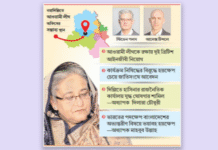Tannery waste taints Dhaleshwari
Partially treated water dumped into the river as CETP still not fully functional; the river, locality, people bear the brunt

Minhaz Uddin was one of over a thousand fishermen who earned a living by fishing in a five-kilometre stretch of the Dhaleshwari river, from Fulbaria to Vakurta downstream.
But ever since the Savar Tannery Industrial Estate started dumping effluents into the river in mid-2016, they had to gradually leave the profession as they were not getting any fish there.
Minhaz, 36, now works at a project for Rohingyas at Noakhali’s Bhasan Char.
“We were around 1,500 fishermen. Everything has changed ever since the tannery estate started dumping waste in the river,” he said. “Many of us became day labourers, rickshaw pullers and many had to find other jobs.”
The operation of the tannery estate in Fulbaria under Savar upazila in so many ways affected the lives of people along the riverbanks down the stream.
They can’t sleep well due to a sickening stench. They can’t use the water for farming or washing livestock anymore. Their children have been warned not to bathe in the river in fear of water-borne diseases.
It was the main source of water for all, but now those who are affluent have opted for electricity-run pumps, resulting in rise in the monthly expenditure.
The tannery waste dumping has brought trouble to over three lakh people of four unions, according to Anwar Hossain, chairman of Hazratpur union.
The problem will aggravate in the weeks and months after the Eid-ul-Azha, when tanners will process millions of raw hides in the estate. Most of the processing job takes place after Eid-ul-Azha.
Last year, some 70 lakh pieces of raw hides of sacrificial animals were processed after the Eid, said Shakhawat Ullah, general secretary of Bangladesh Tanners Association.
Experts say the damage could have been minimised had the tannery estate started its operation only after completion of the central effluent treatment plant (CETP).
Amid environmental concerns, installation of the CETP was a key issue when the government decided to shift the tannery industry from Hazaribagh to Savar.
With a daily capacity of treating 25 thousand cubic metres of waste, the CETP was supposed to be fully operational in 2016 after Chinese firm Ling Xi Environment began the construction in 2014. But the authorities extended the deadline nine times, the latest being June 30 this year.
According to the latest progress report as of June 30, some basic features of the plant are yet to be set up.
The sludge dewatering house has no impact as the electro-mechanical part is yet to be installed. The electrical control cabinet is waiting to be imported from China, say tannery estate officials.
Besides, three chromium recovery units, with a treatment capacity of 350 cubic metres each, still cannot recover the contaminating chemical.
According to experts, a partially completed CETP has little effect in tannery waste management as well as protecting the environment.
“They have no alternative to discharging the partially treated tannery waste into the river. This is the main reason behind the pollution of the Dhaleshwari,” said Prof Khabir Uddin of environment science department at Jahangirnagar University.
Prof Delwar Hossain, chief of the CETP consultant team, admitted that partially treated effluents are being discharged into the river. But he also blamed the factories for not following the guidelines.
“We are yet to control chromium contamination because only 60 to 61 out of 121 operational tanneries are following our guidelines of discharging chrome-contaminated effluents through a separate pipeline,” he said.
“Chrome recovery units are not effective and chrome contaminated-water is being discharged into the river.”
He, however, claimed that the situation has improved over the last one month due to stricter monitoring.
Shakhawat Ullah, general secretary of Bangladesh Tanners Association, rejected the allegation against the factories. “The reality is they [Chinese company] don’t run the CETP for 24 hours.”
Talking to The Daily Star yesterday, Masud Iqbal Md Shamim, director (Dhaka region) of DoE, said, “We visit the tanneries time to time.”
He added that there is a lack of practice of compliances among the tannery owners and workers.
“We haven’t enforced any penalty yet, because most of the components of CETP were incomplete. Recently we have been informed that the status of CETP is good. We will go for enforcement soon.”
He also agreed that the environmental degradation could have been avoided if the CETP was fully functional before the tanneries had gone into production.
Contacted, GN Paul, director of the Savar Tannery Industrial Estate project, admitted that the tannery waste has contributed to Dhaleshwari pollution.
“Due to some internal problems, construction of the CETP was stalled for around two years. Now it has resumed. We will need a few more months to make all the components of the CETP functional and then the pollution could be controlled fully.”
Asked what’s the specific timeframe to complete the CETP, Paul said the Chinese company has asked for six more months beyond the June deadline.
The Daily Star tried to communicate with officials of the Chinese constructor over phone and email. But they didn’t respond.
Talking to newsmen on Wednesday, Md Abdul Halim, secretary to the industries ministry, said almost 97 percent of work of the CETP has been completed.
HEALTH HAZARDS
“Water is slightly better now as it’s the rainy season. In dry season, it is impossible even to stand on the river bank because of the stench,” said Laat Mia, a farmer of Chhoyghoriakandi village, on the west bank of the Dhaleshwari.
While the 70-year-old was talking to this correspondent last month, some kids were seen washing clothes and taking bath in the blackish water of the river. “Children don’t listen to parents. They still bathe in the polluted river and get skin rashes.”
Shimul, an eighth grader, showed rashes on his body. “My family had to spend Tk 5,000 to treat my skin diseases caused from bathing in this river. Now I don’t bathe here.”
Rabeya Khatun, 45, mother of three, said health problems like fever, cough, allergy, and skin problems are on the rise in the area due to contaminated river water.
The Daily Star analysed the Dhaleshwari water test reports from July 2017 to June this year, conducted by the environment department considering different parameters including biochemical oxygen demand (BOD), dissolved oxygen (DO) and chromium.
The reports show that the tannery waste has a negative impact on Dhaleshwari over the years.
However, the report on June 15 found a slight improvement in DO — 5.2mg per litre against permissible limit of minimum 5mg. It happened because “the rainy season has an influence”, experts say.
Another test by Buet’s civil engineering department found BOD at 1.5mg per litre, based on sample collected on July 6 from 10 metres downstream from the dropping point of waste. It found BOD at 12.8mg per litre in June against the limit of 5mg.
“Higher level of BOD and lower level of DO mean no aquatic animal could live in that water,” said Prof Khabir Uddin of Jahangirnagar University.
Asked whether the pollution from tannery can have direct impact on the public health, Prof Nazma Shaheen of food and nutrition science institute at DU, said, “The people in Hazaribagh complained of same problems when the tannery was there.”
She added, “Once the tannery killed the Buriganga, now it is killing Dhaleshwari.”









